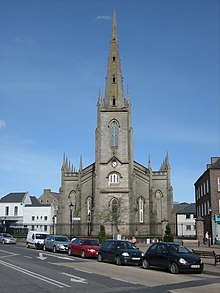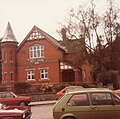Monaghan
Monaghan
Muineachán (Irish) | ||
|---|---|---|
Town | ||
 | ||
|
Eircode routing key H18 | ||
| Telephone area code | +353(0)47 | |
| Irish Grid Reference | H666337 | |
Monaghan (/ˈmɒnəhən/ MON-ə-hən;[2] Irish: Muineachán[3] [ˈmˠɪnʲəxaːnˠ]) is the county town of County Monaghan, Ireland. It also provides the name of its civil parish and barony.
The population of the town as of the 2022 census was 7,894.[1] The town is on the N2 road from Dublin to Derry and Letterkenny.[4]

Etymology
The Irish name Muineachán derives from a diminutive plural form of the Irish word muine meaning "brake" (a thickly overgrown area) or sometimes "hillock". The Irish historian and writer Patrick Weston Joyce interpreted this as "a place full of little hills or brakes".[5] Monaghan County Council's preferred interpretation is "land of the little hills", a reference to the numerous drumlins in the area.
History
Early history
The Menapii Celtic tribe are specifically named on

The
In 1801, Monaghan Town, along with the rest of the Rossmore Estate, became the property of the Westenra family.
Transport
The
The Ulster Railway linked Monaghan with
Twentieth century
In February 1919 the first self-consciously proclaimed soviet in the United Kingdom was established at Monaghan Lunatic Asylum.[8] This led to the claim by Joseph Devlin in the House of Commons of the United Kingdom that "the only successfully conducted institutions in Ireland are the lunatic asylums".[9]
On 17 May 1974 an
A monument in memory of the victims was unveiled by the eighth President of Ireland Mary McAleese on 17 May 2004, on the occasion of the 30th anniversary of the atrocity. The sandstone and metal column containing seven light wells bearing the names of each of the seven victims of the bombing was designed by Ciaran O'Cearnaigh and stands as a reminder of one of the darkest days in Ireland's modern history.
Culture

Monaghan continues to host one of Ireland's most prestigious and established blues festivals,[12] the Harvest Time Blues Festival. It is hosted every September across Monaghan town.[13]
The Fiddler of Oriel Muineachán Competition (also known as Féile Oriel) first held in 1969 returned in 2009 to celebrate its fortieth anniversary.
Founded in 1974, Monaghan County Museum is recognised as one of the leading provincial museums in Ireland, with a prestigious Council of Europe Award conferred in 1980, among others, to its credit. The museum is located in a mid-Victorian stone building of three stories, formerly two separate town houses, on Hill Street. It aims to acquaint its visitors with the history of County Monaghan and its people.
The Garage Theatre is an arts facility located on the Monaghan Education Campus. It hosts a wide range of activities including drama, music, dance and film.[15]
The town is home to Monaghan United Football Club, formerly of the League of Ireland Premier Division.
Local government

Local issues are dealt with by the Monaghan Municipal Council which elects six members, all of which are elected as members of Monaghan County Council. The town forms part of the Monaghan ward for local elections for elections to Monaghan County Council and part of the Cavan–Monaghan constituency for elections to Dáil Éireann. Monaghan Town Hall is a former bank branch dating from around 1880.[16]
The largest party on the municipal council is Sinn Féin, which holds two of six seats. Fine Gael and Fianna Fáil each hold one seat and there are two independent members.[citation needed]
Town layout and architecture
The centre of the town is made up of four interconnecting squares: Market Square (or Street), Church Square, The Diamond and Old Cross Square.

Dating from the seventeenth century, the oldest remaining architectural feature in Monaghan town is the "Old Cross" – located in Old Cross Square. It is not fully agreed that it is in fact a cross, but may in fact have been a seventeenth-century sundial. It was originally located in the Diamond, the traditional centre of the town, and was used as a hiring cross and for the attaching of proclamations. It was moved to its present location in 1876 to allow for the construction of the Rossmore Memorial. Two landmark buildings remain from the eighteenth century, Aviemore House (built in 1760) on Mill Street and the "extremely elegant" Market House (from 1792) on Market Square.[17]: 16
Monaghan is notable for the quality of its nineteenth-century architecture, which adds a sense of dignity to the attractive town centre and its environs. Of its Victorian buildings, the
The Rossmore Memorial in The Diamond was built in 1876 as a memorial to The 4th Baron Rossmore, who died after a hunting accident at Windsor Castle in 1874. This Victorian monument, described by architectural historian C.E.B. Brett as "formidable and striking"[17]: 10 is octagonal in shape, with central marble columns supporting a fountain. Around it, the eight grey columns support the pinnacled superstructure which rises to a dome. The dome is surmounted by a spire supported by yet more columns. The letters of Rossmore (also eight in number) are spaced out around the monument.

The Gothic-Revival

Church Square is very much an environment in which the civic pride of Victorian improvers lives on in the satisfying essay in the Ruskinian-Gothic style that is the Bank of Ireland building, as much as in the peaks of St. Patrick's Church of Ireland and the Dawson Obelisk. One of the most interesting aspects of Monaghan's Victorian architectural heritage, which also includes the former railway station, the Orange Hall on North Road and the Westenra Hotel on the Diamond, is the rounded corners that connect the town's buildings from one street or square to the next. This practice of rounding corners in order to open up panoramic vistas was carried out with unprecedented frequency in the town of Monaghan, and is still reflected today in the edifices of The Diamond, Church Square and Mill Street, helping to secure Monaghan's status as one of Ulster's more attractive large towns.
Economy
The town is a centre for the timber-frame house building industry with
There is a campaign to boost tourism by reopening the Ulster Canal in a scheme which would eventually allow boats to travel from towns in Northern Ireland, such as Newry, by way of Monaghan to places as far south as Limerick, as well as Dublin.
Monaghan once had a thriving furniture manufacturing industry. Since 1990, this has diminished greatly under global competition. However, manufacturers such as Rossmore Furniture (which took its name from Rossmore Forest Park, situated just outside the town) continue to operate from the town.
Transport
Public transport operator Bus Éireann routes 32 (Dublin/Letterkenny),[21] 65 (Galway/Athlone/Monaghan),[22] 162 (Monaghan/Dundalk),[23] 175 (Monaghan/Cootehill/Cavan),[24] 182 (Drogheda/Collon/Ardee/Monaghan)[25] all service the town.
TFI Local Link services the town via the following routes:
- M1 (Knockatallon – Tydavnet – Scotstown – Ballinode – Monaghan Town Centre – Coolshannagh – Monaghan Institute)[26]
- M2 (Ballybay – Beechgrove – Library – Monaghan Hospital – Monaghan Bus Station – Rooskey – Monaghan Institute)[27]
- M3 (Mullan Village – Emyvale – Glaslough – Tyholland – Tullygony – CombiLift – Monaghan Institute – Monaghan Town – Latlorcan)[28]
- 176 (Cavan Town – Ballyhaise – Scotshouse – Clones – Newbliss – Threemilehouse – Monaghan Town)[29]
Notable people
- Jonathan Douglas, footballer[citation needed]
- The Rt Hon. Sir Charles Gavan Duffy, politician and co-founder of The Nation, subsequently the eighth Premier of Victoria, was born at 10 Dublin Street.[30]
- Jim Lynagh, Republican martyr who was a volunteer in the East Tyrone Brigade of the Provisional Irish Republican Army
- Juan MacKenna, hero of the Chilean War of Independence[31]
- Caoimhghín Ó Caoláin, politician[citation needed][relevant?]
- Nathaniel Walter Swan (1834–1884), Australian writer, was born in Monaghan[32]
- William Temple, recipient of the Victoria Cross[citation needed]
- Sir William Whitla, politician and physician[33]
- Alexander Williams, artist[34]
Sister city
Monaghan is twinned with Miramichi, New Brunswick.[citation needed]
Gallery
-
Entrance detail of Masonic Hall, 1989
-
Glaslough Street, 1989, looking west
-
Glaslough Street, 1989, looking east
-
Orange Hall, North Road, 1989
See also
- List of towns and villages in the Republic of Ireland
- Market Houses in the Republic of Ireland
- Monaghan United F.C., a local football team
References
- ^ a b "Interactive Data Visualisations: Towns: Monaghan". Census 2022. Central Statistics Office. Retrieved 26 September 2023.
- ^ "Monaghan definition and meaning". Collins English Dictionary. Archived from the original on 10 March 2021. Retrieved 4 January 2020.
- ^ "Muineachán/Monaghan". Placenames Database of Ireland (logainm.ie). Retrieved 13 March 2023.
- ^ Monaghan Health Status Report
- ^ Joyce, Patrick Weston (1870), Irish Local Names Explained.
- ^ The Buildings of Ireland: South Ulster. London: Yale.
- ^ ISBN 0-7153-5167-2.
- ISBN 9780745311234.
- ^ Hansard Archived 11 July 2009 at the Wayback Machine, 20 February 1919, accessed 18 July 2010
- ^ "Justice for the Forgotten". www.dublinmonaghanbombings.org. Archived from the original on 10 May 2017. Retrieved 1 December 2016.
- ^ "CAIN:Sutton Index of Deaths 1974". CAIN (Conflict Archive on the Internet). Archived from the original on 26 February 2019. Retrieved 14 August 2020.
- ^ Monaghan Post, 6 September 2007. "Who's Behind the Blues? Archived 12 July 2009 at the Wayback Machine"
- ^ "www.HarvestBlues.ie". Archived from the original on 4 August 2009. Retrieved 8 September 2009.
- ^ Fiddler of Oriel Muineachán Competition Archived 10 July 2011 at the Wayback Machine
- ^ "The Garage Theatre". The Garage Theatre. Archived from the original on 7 July 2020. Retrieved 4 July 2020.
- ^ "Monaghan Town Hall, 1 Dublin Street, Roosky, Monaghan, County Monaghan". National Inventory of Architectural Heritage. Retrieved 7 December 2023.
- ^ a b c Brett, C.E.B. (1970). Historic Buildings, Groups of Buildings and Areas of Architectural Importance in the Town of Monaghan. Belfast: Ulster Architectural Heritage Society.
- ^ "Maurice Moffett Ltd". Archived from the original on 29 September 2010. Retrieved 5 October 2010.
- ^ Combilift Inc. Archived 25 October 2012 at the Wayback Machine
- ^ "Combilift 2. Background". Enterprise Ireland. 2010. Archived from the original on 10 July 2011. Retrieved 5 October 2010.
- ^ "32-1669936108.pdf" (PDF). Bus Éireann. Retrieved 25 August 2023.
- ^ "3445.pdf" (PDF). Bus Éireann. Retrieved 25 August 2023.
- ^ "875.pdf" (PDF). Bus Éireann. Retrieved 25 August 2023.
- ^ "3032.pdf" (PDF). Bus Éireann. Retrieved 25 August 2023.
- ^ "2122.pdf" (PDF). Bus Éireann. Retrieved 25 August 2023.
- ^ "M1-Timetable-August-2023-web.pdf" (PDF). Local Link Cavan-Monaghan. Retrieved 25 August 2023.
- ^ "M2-Timetable-August-2023-web.pdf" (PDF). Local Link Cavan-Monaghan. Retrieved 25 August 2023.
- ^ "M3-Timetable-August-2023-web.pdf" (PDF). Local Link Cavan-Monaghan. Retrieved 25 August 2023.
- ^ "176-Timetable-June-22-web.pdf" (PDF). Local Link Cavan-Monaghan. Retrieved 25 August 2023.
- ^ "Birthplace of Charles Gavin Duffy, Dublin Street, ROOSKY, Monaghan, MONAGHAN". Buildings of Ireland. Archived from the original on 17 May 2021. Retrieved 10 June 2021.
- ^ Brett, C.E.B. "Historic Buildings, Groups of Buildings and Areas of Architectural Importance in the Town of Monaghan". Belfast, Ulster Architectural Heritage Society, 1973, p. 28.
- ^ Mennell, Philip (1892). . – via Wikisource.
- ^ "Ulster Medical Society: William Whitla". Archived from the original on 11 May 2021. Retrieved 11 June 2021.
- ^ Baker, Audrey (2009). "Williams, Alexander". Dictionary of Irish Biography – Cambridge University Press. Archived from the original on 28 January 2021. Retrieved 11 June 2021.






